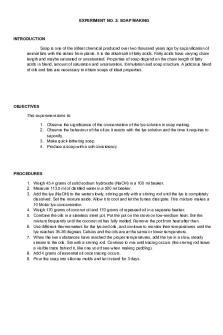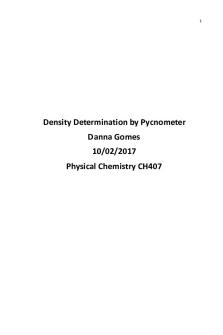Laboratory report for BIO PDF

| Title | Laboratory report for BIO |
|---|---|
| Author | Nique Johnson |
| Course | Anatomy And Physiology Ii |
| Institution | University of Phoenix |
| Pages | 4 |
| File Size | 177.2 KB |
| File Type | |
| Total Downloads | 91 |
| Total Views | 143 |
Summary
Lab results for assignments. homework and study notes....
Description
Laboratory Report
LABORATORY REPORT Activity: Name: Instructor: Date:
Enzyme Activity Tenique Johnson Elizabeth Kraske 07.23.2021
Predictions 1. Sucrase will have the greatest activity at pH 3 2. Sucrase will have the greatest activity at 40 °C (104 °F)
3. Sucrase activity increases with increasing sucrose concentration until a plateau is reached
Materials and Methods Effect of pH on Enzyme Activity 1. Dependent Variable amount of product (glucose and fructose) produced
2. Independent Variable pH
3. Controlled Variables temperature, amount of substrate (sucrose) present, sucrase + sucrose incubation time
Effect of Temperature on Enzyme Activity 1. Dependent Variable amount of product (glucose and fructose) produced
2. Independent Variable temperature
3. Controlled Variables pH, amount of substrate (sucrose) present, sucrase + sucrose incubation time
Effect of Substrate Concentration on Enzyme Activity 1. Dependent Variable amount of product (glucose and fructose) produced
2. Independent Variable amount of substrate (sucrose) present
3. Controlled Variables temperature, pH, sucrase + sucrose incubation time
4. Describe what is measured as an indicator of sucrase activity and why this is an indicator of sucrase activity. The amount of glucose and fructose formed will be an indicator of sucrase activity. This is an absolute indicator of sucrase activity because the amount of the activity.
Laboratory Report/ Tenique Johnson/ Enzyme Activity/ Elizabeth Kraske/ 07.23.2021/ Page [1] of [4]
Laboratory Report
5. Explain why denatured sucrase was used as a control. Denatured sucrase was used as a control to check the presence and activity of experimental sucrase and also to confirm that the changes in experimental set up is due to sucrase activity.
6. Addition of DNS at the end of the incubation period stopped the reaction by denaturing sucrase. Explain why it is important to denature sucrase before measuring product concentration. It is important to denature sucrase before measuring product concentration to stop the continuous enzyme activity and product formation.
Results Table 4: Effect of pH on Sucrase Activity ph 3 0.193 0.169 0.165 0.176
1 2 3 average
ph 4 0.340 0.337 0.328 0.335
ph 5 0.671 0.636 0.631 0.646
Optical Density ph 6 0.961 0.932 0.957 0.950
ph 7 0.801 0.822 0.784 0.802
ph 8 0.421 0.421 0.431 0.424
ph 9 0.184 0.179 0.157 0.173
Effect of pH on Sucrase Activity Glucose (O.D. units) 1 0.8 0.6 0.4 0.2 0 3
4
5
6
7
8
9
pH
1. State the optimum pH for sucrase activity and describe how sucrase activity changes at more acidic and more alkaline pH values. The optical density corresponds to amount of glucose released from sucrose as a result of sucrase activity. Higher the optical density, higher will be the sucrase activity.
2. Was the rate of increase of sucrase activity higher at a pH of 8.5 or a pH of 5.5? The enzyme activity will be higher at pH 5.5 than at pH 8.5. This is because pH 5.5 is much closer to the optimal pH of sucrase than pH 8.5.
Table 5: Effect of Temperature on Sucrase Activity 10 °C (50 °F) 0.008 0.007 0.010 0.008
1 2 3 average
20 °C (68 °F) 0.289 0.300 0.267 0.285
30 °C (86 °F) 0.792 0.762 0.796 0.783
Optical Density 40 °C (104 °F) 0.922 0.939 0.964 0.942
Effect of Temperature on Sucrase Activity Glucose (O.D. units) 1 0.8 0.6 0.4 0.2 0 10
20
30
40
50
60
70
t, °C
Laboratory Report/ Tenique Johnson/ Enzyme Activity/ Elizabeth Kraske/ 07.23.2021/ Page [2] of [4]
50 °C (122 °F) 0.934 0.910 0.940 0.928
60 °C (140 °F) 0.846 0.806 0.812 0.821
70 °C (158 °F) 0.618 0.644 0.618 0.627
Laboratory Report
3. State the optimum temperature for sucrase activity and describe how sucrase activity changes at lower and higher temperatures. This means higher the Sucrase activity, higher will be the glucose concentration. The glucose concentration in terms of OD indicates Sucrase activity. 4. Was sucrase activity higher at 25 °C or 55 °C? Sucrase activity was higher at 55 degree Celsius than at 25 degree Celsius because higher the glucose concentration, higher is the Sucrase activity.
Table 6: Effect of Sucrose Concentration on Sucrase Activity
1 2 3 average
35 g/L 0.988 1.002 1.014 1.000
30 g/L 0.996 1.000 0.987 0.994
25 g/L 0.944 0.943 0.945 0.944
Optical Density 20 g/L 15 g/L 0.900 0.850 0.903 0.858 0.891 0.864 0.898 0.857
10 g/L 0.750 0.778 0.759 0.762
5 g/L 0.492 0.490 0.511 0.498
0 g/L 0.001 0.000 0.003 0.001
Effect of Sucrose Concentration on Sucrase Activity Glucose (O.D. units) 1 0.8 0.6 0.4 0.2 0 0
5
10
15
20
25
30
35
final sucrose concentration, g/l
5. State how sucrase activity changes with increasing sucrose concentration. In the first stages sucrase activity is directly proportional to sucrose concentration. When sucrose concentration reaches a particular level of 30g/l sucrase activity becomes constant. No increase. 6. Was the rate of increase of sucrase activity greater when sucrose concentration went from 2.5 to 7.5 g/l or when it went from 22.5 to 27.5 g/l? Rate of increase of sucrase activity is greater when sucrose concentration went from 2.5-7.5g/l than from 22.5-27.5g/l.
pH Along the GI Tract Organ
mouth
stomach
pH
6.35 - 6.85
1-3
duodenum (first section of small intestine) 6
jejuneum (second ileum (third section section of of small intestine) small intestine) 7.5 7.5
colon
7.5 - 8
Discussion 1. Referring to the table above, specifically state where in the intestine sucrase is likely most active. In the intestine sucrase activity is more in the duodenum. Because the ph in duodenum is 6.optimum ph(ph at which maximum enzyme activity present) of sucrase is approximately 6 (range-4.5-7.0)
2. Compare optimal temperature for sucrase activity to body temperature. Optimal temperature for sucrase is 40 C or 104 Farenheit. Our body temperature is about 98.6 farenheit or 37C.sucrase have no optimal activity at body temperature. 3. How would a slight fever affect sucrase activity? A slight fever increases body temperature slightly so that it reaches near the optimal temperature of sucrase. This increases sucrase activity.
4. Explain how pH of intestine and temperature of body together affect enzyme activity.
Laboratory Report/ Tenique Johnson/ Enzyme Activity/ Elizabeth Kraske/ 07.23.2021/ Page [3] of [4]
Laboratory Report
Enzymes are most active at their optimum ph and temperature conditions. The body temperature is normally optimal for almost all enzymes with slight variations as in case of sucrase. Intestines has 3 regions with different ph which allows a particular enzyme to act at any one of the 3 regions. 5. Explain how increasing amount of sucrose in food affects sucrase activity. Increasing amount of sucrose in food increases sucrase activity but only up to a particular level of sucrose concentration as seen in the above graph. After that if sucrose concentration is increased it does not affect sucrase activity. 6. In the results section you were asked if rate of increase of sucrase activity was greater when sucrose concentration went from 2.5 to 7.5 g/l or when it went from 22.5 to 27.5 g/l. Explain why the rate of increase was greater for this range. At first stages when ph went from 2.5 to 7.5 g/l rate of increase of sucrase activity was greater. But when it went from 22.5 to 27.5 g/l increase in sucrase activity was lower. This is because when sucrose concentration was low more sucrase enzyme molecules are available for action. When sucrose concentration increased these enzymes got occupied and availability of free enzymes was low. Almost all enzymes got saturated with sucrose.
7. In this experiment, if the sucrose concentration were increased to 70 g/l would you expect sucrase activity to be significantly higher than the activity at 35 g/l. Explain your answer. If sucrose concentration is tremendously increased from 30g/l to 70 g/l overall sucrase activity will be increased. But not much increase will be noted as enzymes will be saturated. There will also be increase in glucose and fructose. 8. Restate your predictions that were correct and give the data from your experiment that supports them. Restate your predictions that were not correct and correct them, giving the data from your experiment that supports the corrections. I predicted that the ph 7 would have greater activity than ph 6. I believed this in the beginning since it was a higher number, it would have been more activity. I now know that ph 6 has greater activity after further research.
Application 1. Myosin ATPase is an enzyme that is involved in muscle contraction. Athletes do warm-up exercises prior to athletic performance. Explain why warm-up exercises increase myosin-ATPase activity. Warm-up exercises loosens the muscles and increase blood flow to muscles and lessens chance of injury. It also activates myosin ATPase so that myosin heads are activated and increase muscle contraction. Describe how increasing myosin-ATPase activity affects muscle contraction. Increasing myosin ATPase activity increases myosin head activation. This causes more binding of myosin heads to actins. More stronger binding results in increased force of contraction and increase performance of athletes.
2. Salivary amylase, an enzyme in saliva that breaks down starch, has an optimal pH of 6.7-7.0. Explain why salivary amylase is active in the mouth, but becomes inactive in the stomach. Optimum ph of salivary amylase is about 6.7 - 7.0.ph of mouth is 6.7-7.3.so salivary amylase is active in the mouth. When it reaches the stomach, ph lowers below 5.0 and salivary amylase becomes inactive. It cannot act at the acidic ph of the stomach.
Laboratory Report/ Tenique Johnson/ Enzyme Activity/ Elizabeth Kraske/ 07.23.2021/ Page [4] of [4]...
Similar Free PDFs

Laboratory report for BIO
- 4 Pages

Bio lab 101 laboratory 2
- 2 Pages

Lab 1 - Laboratory Report
- 10 Pages

Laboratory+report+1-4
- 11 Pages

Laboratory 11 - Lab Report
- 3 Pages

Laboratory report - aspirin
- 8 Pages

Laboratory Report 1 SKO3023
- 30 Pages

Laboratory Report Rubric
- 2 Pages
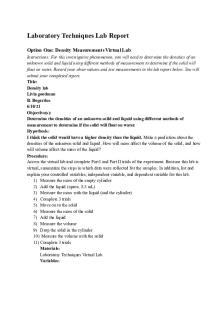
Laboratory Techniques Lab Report
- 4 Pages

LABORATORY REPORT EXPERIMENT 5
- 6 Pages
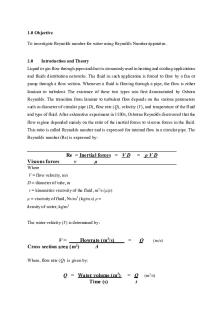
Reynold\'s Number Laboratory Report
- 11 Pages
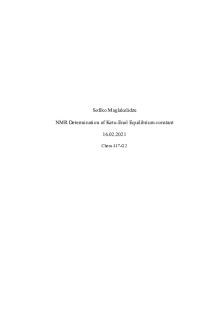
NMR Laboratory Report
- 17 Pages

Experiment 23 laboratory report
- 7 Pages

Laboratory Values for NCLEX
- 4 Pages
Popular Institutions
- Tinajero National High School - Annex
- Politeknik Caltex Riau
- Yokohama City University
- SGT University
- University of Al-Qadisiyah
- Divine Word College of Vigan
- Techniek College Rotterdam
- Universidade de Santiago
- Universiti Teknologi MARA Cawangan Johor Kampus Pasir Gudang
- Poltekkes Kemenkes Yogyakarta
- Baguio City National High School
- Colegio san marcos
- preparatoria uno
- Centro de Bachillerato Tecnológico Industrial y de Servicios No. 107
- Dalian Maritime University
- Quang Trung Secondary School
- Colegio Tecnológico en Informática
- Corporación Regional de Educación Superior
- Grupo CEDVA
- Dar Al Uloom University
- Centro de Estudios Preuniversitarios de la Universidad Nacional de Ingeniería
- 上智大学
- Aakash International School, Nuna Majara
- San Felipe Neri Catholic School
- Kang Chiao International School - New Taipei City
- Misamis Occidental National High School
- Institución Educativa Escuela Normal Juan Ladrilleros
- Kolehiyo ng Pantukan
- Batanes State College
- Instituto Continental
- Sekolah Menengah Kejuruan Kesehatan Kaltara (Tarakan)
- Colegio de La Inmaculada Concepcion - Cebu
